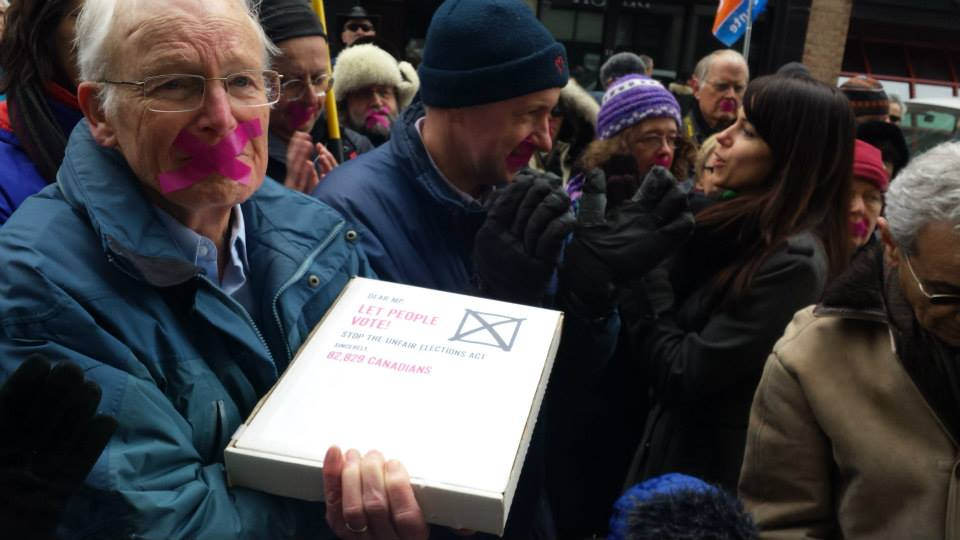The Fair Elections Act received Royal Assent last June and is now the law of the land.
The hue and cry of protest from the opposition, the media, almost every reputable expert, and tens of thousands of Canadians had virtually no effect.
The Conservatives pushed their oxymoronically named legislation through with only a few amendments.
Now, it seems we have all moved on. There are other matters to excite and worry us: war in the Middle East, global warming and the Harper government’s indifference to it, Ebola — and let us not forget the latest opinion polls.
The Council of Canadians and the Canadian Federation of Students have not forgotten about Democratic Reform Minister Pierre Poilievre’s assault on Canadians’ basic right to vote. And they have not yet surrendered.
On Thursday, the Council and the Federation, together with three voters, announced that they are taking the federal government to court, seeking to overturn a number of the provisions of Poilievre’s elections act.
Here is what they want the Ontario Superior Court to strike:
- The Act’s limitations on the right of Chief Electoral Officers to communicate with the public and the media as they see fit.
- The bizarre limits on educational activities the Chief Electoral Officer can conduct. The Act perversely provides that such activities may only be directed at Canadians too young to vote.
- The additional prohibition in the new Elections law against Chief Electoral Officers communicating to Parliament and the public on investigations into electoral fraud, such as the “robocall” incidents during the 2011 election.
- Moving the official who investigates electoral fraud, the Commissioner of Elections, out of Elections Canada, which reports to Parliament not the government, and into the office of the Director of Public Prosecutions, which reports to the government through the Minister of Justice.
- The Act’s banning of the use of the Voter Information Card (VIC) as corroborating identification for voters. The key word here is corroborating. VICs have only been used in conjunction with other ID. The Act – for reasons never full explained — banned them completely, over the vigorous objections of the Chief Electoral Officer.
- The end of the time-honoured practice of vouching, whereby a qualified voter, under oath, can vouch for another vote who has no, or only insufficient, ID. Vouching allowed 100,000 Canadians to vote last time.
The lawyer handling the case, Steven Shrybman, explains that the offending provisions of the Fair Elections Act run counter to Canadians’ right to vote, guaranteed in Section 3 of the Charter of Rights and Freedoms and, in some cases, to Canadians’ right to equal treatment, guaranteed in Section 15 of the Charter.
The basic right to vote is so sacrosanct that Section 3 of the Charter is immune to the Notwithstanding Clause. Parliament cannot in any way, even temporarily, change it through legislation.
And the courts have been generous in interpreting the constitutional right to vote.
Court decisions have deemed that the Section 3 right includes the right to vote without unreasonable barriers, for instance, and the right to fully participate in the democratic process.
As for Section 15, both Garry Neil of the Council of Canadians and Jessica McCormick of the Federation of Students pointed out that the new restrictive ID requirements of the Fair Elections Act will unfairly target the young, the poor, marginalized people and Aboriginals. Students, for instance, are often transient and could find it expensive or, at best, cumbersome to come up with the two pieces of ID, one of which must include current address, which the Act requires.
The Fair Elections Act’s attacks on the power of Elections Canada to monitor, investigate and prosecute cases of fraud, and inform the public about them, are particularly outrageous, given that it was the robocall fraud incidents that brought about the call for reforms in the first place.
If Poilievre were in charge of traffic, let us say, and red light cameras indicated that an alarming number of drivers were running the lights at certain intersections, his solution would be to remove the cameras.
Further, if any police officer witnessed cases of red light running, Poilievre would deny them the right to inform the public.
That is pretty much what the Minister of Democratic Reform did in his Fair Elections Act.
Shrybman says he hopes to get a hearing in Ontario Superior Court before the end of 2014, in time for a decision before the official October 2015 date of the next election.
Some of the measures the two organizations and three voters seek to overturn are already in place.
About a week ago, the Director of Public Prosecutions issued a bland press release informing anyone interested that the Commissioner of Elections was now officially part of his team. The Prosecutor’s staff, we are to assume, will be ordering extra coffee for their new colleagues.
But the greatest damage the Fair Elections Act might wreak will only happen at the time of the next election. Hence the urgency to get the courts to set aside recently enacted legal measures that might prevent many Canadians from voting.
Shrybman is optimistic that the Superior Court will agree that a number of key pieces of the Fair Elections Act are unconstitutional.
Judges (even those appointed by Prime Minister Harper) have not been reluctant to overturn Conservative government initiatives, from the appointment of an unqualified Supreme Court Justice to the cancellation of the Refugee Health Program.
The Fair Elections case is almost certainly the biggest one that has landed in the judiciary’s lap. In a real sense, this case will have an impact on us all.
Image: Flickr/Leadnow.ca




